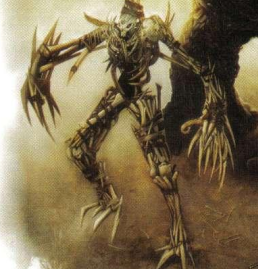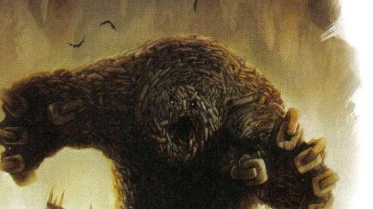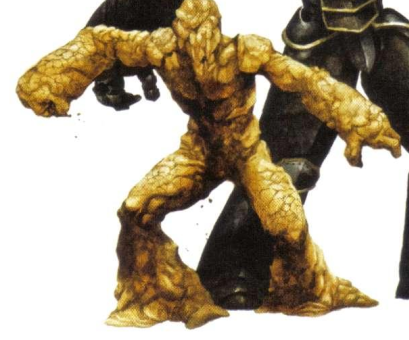Let's Read the 4e Monster Manual 2: Golem
Golems showed up in the first MM and were iconic enough to later make it to the Monster Vault. I covered those here, and you can check that same post to see their basic lore. The Monster Manual 2 brings us yet more golems, which share the same basic lore.
As before, golems are Natural Animates with the Construct keyword. They’re immune to disease, poison, and sleep. They have darkvision, and though their ground speed tends to be high they cannot shift. Most are Large, but one of the examples here is Huge.
Bone Golem

Bone golems are made from the skeletons of several creatures, whose bones are sharpened and fitted together to form the construct’s body. Despite being made of bones and beloved of necromancers, it’s a construct animated through elemental magic and not an undead monster. Throw this one into an encounter that does have undead skeletons in it, and it should be good to surprise your PCs a bit.
Bone Golems are Level 12 Elite Brutes with 302 HP. It’s so spiky the pointy bits count as a Bone Spikes aura (1) that deals 5 damage to any enemy that enters it. The pointy bits also justify the Osseous Retaliation trait, which deals a bit of automatic damage to anyone who hits the golem with an opportunity attack.
This construct fights with Reach 2 Bone Spurs, and can attack twice per action with them. It can also fire a Bone Volley (burst 3 vs. Reflex, recharge 6+) that deals heavy physical damage and dazes (save ends).
When the golem is destroyed Bone Death allows it to make one last attack. If Bone Spurs is charged then it uses that, otherwise it makes a basic bone spur attack.
Chain Golem

These Huge golems are modeled after chain devils, and are often tasked to guard prisons and Actual Dungeons instead of the usual tombs or treasure vaults. As you might have guessed, their fighting style is very grapple-intensive.
Chain Golems are Level 22 Elite Soldiers with 418 HP, a speed of 8, and all standard golem traits. Their Entangling Chains act as an aura (3) that slows everyone caught inside.
Their basic attack is a Reach 3 Chain that does physical damage and pulls the target 2 squares. Chain Smash is their double attack power, allowing it to attack two different targets in one action. While they’re bloodied, Berserk Attack allows them to make a chain strike against anyone who damages them as a reaction.
All that and we didn’t even use the grappling rules yet! We have to do that for Chain Grab, though. This at-will attack is a Close Burst 2 that does the same damage as the basic strike, pulls targets 1 square, and grabs them. The escape DC is 32 or 35 depending on the skill you use. The golem can move away from the grabbed victims without ending the grab because chains. Once it finishes moving it can either slide the victims next to itself or let them go.
So your typical chain golem will try to keep the whole party grabbed while it smacks them around with its chains. PCs who aren’t grabbed will still be slowed, and the golem’s strikes will pull them back if they try to run away. Staying far away and using ranged attacks is a good tactic against them, but that speed of 8 will make keeping away a real chore.
Clay Golem

Clay Golems were one of the original golem types described in the first entries back in AD&D or in the nebulous times before it. They were originally inspired by the legend of the golem of Prague, and so were the only golem that required divine magic to make (all the others were arcane).
In Fourth Edition, eidolons are used to represent divine constructs, so clay golems have the same arcane/elemental origin as the other types. They have a somewhat “runny” appearance, but are surprisingly fast and retain a slightly less harsh version of the ability to inflict unhealing wounds that they had in previous incarnations.
Stat-wise, they’re Level 15 Elite Brutes with 368 HP, Large size, a speed of 6, and all common golem traits. Their basic attack is a Reach 2 Slam that does heavy physical damage and curses the target, making it unable to regain HP. This is a (save ends) condition, but it’s still quite dangerous, since it makes wounds inflicted by all enemies unhealing, not just the golem’s. Clay Smash allows it to slam two different targets in one action, and they have the same Berserk Attack reaction as the chain golem above.
Their Hasty Reaction passive trait allows them to roll initiative twice and take the highest result, and Unstoppable is a move-action encounter power that allows them to move 8 squares and pass through enemy spaces. They draw opportunity attacks when doing this, but reduce their damage by 10. This isn’t worded like a resistance, so I guess powers that bypass or reduce resistances don’t work against it.
Iron Golem
These made it into the MV, so we already covered them. The MM2 has two versions, the Level 20 one that we saw, and a Level 26 “Iron Golem Juggernaut” that’s basically the same aside from being size Huge and having bigger numbers.
Sample Encounters and Final Impressions
Each kind of golem presented here gets a sample encounter. I guess there was something of an editing snafu here, because most golems have their encounter listed right after their stats, but the one for chain golems is all by its lonesome in an “Encounter Groups” section at the end of the overall entry. I guess it must be there because it has two golem types in it.
-
Level 13: 1 bone golem, 4 horde ghouls (minions), 1 human wizard lich. So that’s the kind of caster who makes bone golems.
-
Level 15: 1 clay golem, 1 shadar-kai gloom lord, 2 shadow snakes. A Zehiri operation, if you still want to associate clay golems with clerics.
-
Level 21: 1 chain golem, 1 dark naga, 1 iron golem. Someone really wanted this place guarded.
-
Level 24: 1 iron golem juggernaut, 1 storm gorgon, 1 djinn skylord. A noble, his pet, and his mechanical manservant.
There’s a point past which adding more golem types feels a bit redundant. There are also so many non-golem constructs out there that I almost think “golem” should be a singular monster type with very specific characteristics, rather than a whole family of them. Otherwise it would be best to do away with the term entirely.